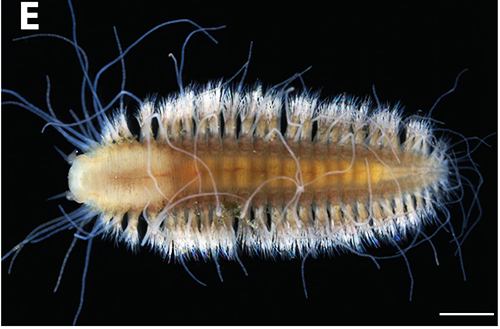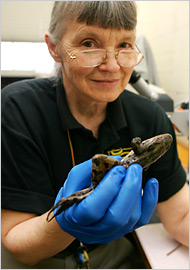Making History One Species at a Time
Making History One Species at a Time

In a research laboratory tucked away on the second floor of Deering Hall at the University of Maine, a researcher has been changing the world of science as we know it. Her office is lined with shelves busy with textbooks, papers and scientific journals that make the room feel larger than its dimensions. Here, Joyce Longcore, School of Biology and Ecology research scientist has happily conducted her research for the past 20 years, discovering new species of fungi.
School of Biology and Ecology faculty and researchers are making their marks in science’s history — one species at a time. The discovery of new species has a large impact on the environment, and to the ever-changing world of science as a whole.
Longcore is an expert in the field of mycology, specializing in a group of organisms only a handful of individuals around the world study intensively, a group of microscopic fungi commonly referred to as chytrids.
In 1997, Longcore received an email that would change her career. The Smithsonian National Zoological Park in Washington, D.C, was looking for researchers who had information on an unidentified organism that had been devastating their poisonous dart frog’s populations; the same organism that had been killing off amphibians in Central America and Australia.

After reviewing electron microscopy images of the organism and analyzing a tissue sample from an infected frog, it quickly became apparent to Longcore that the organism was a chytrid, a member of the group she had been studying. Chytrids fall within the phylum Chytridiomycota, a lineage in the fungal kingdom identified by the formation of uni-flagellated reproductive cells. But this particular chytrid had not been described yet within the scientific community. Longcore and her colleagues had discovered a new species.
“We knew it was an important disease found in several parts of the world,” said Longcore. “No chytrid had been seen to be pathogenetic to a vertebrate before. I used the culture to do electron microscopy in order to determine its relationship within the chytrids and began the process of naming and describing it.”
Though this species of amphibian-pathogenic chytrid, Batrachochytrium dendrobatidis, was not the first species Longcore discovered in Chytridiomycota, this discovery drew attention around the world to the formerly obscure group of organisms. Longcore first became interested in chytrid fungi when she was in her early 20’s as an undergraduate at the University of Michigan. She received her PhD from the University of Maine in 1991. Longcore is now well known in the mycological community. She runs the Maine Chytrid Laboratory at University of Maine, where she maintains a diverse culture collection of chytrid isolates from around the world. The world-renowned collection is funded by grants and the sales of her isolates. She distributes these isolates to other researchers interested in studying the species for research or teaching purposes.
Longcore has been a member of the Department of Biology and Ecology for twenty-five years now, collecting and studying her favorite microscopic fungi. Her research, which has drawn attention from scientists around the world, is biologically relevant for discovering news species and saving the ones in danger of extinction.
According to National Geographic, our planet is home to 8.7 million species… and approximately eighty six percent of Earth’s species still have not been fully described. So what happens when a scientist discovers what they believe to be an un-described species?
In order to name and describe a species, a variety of steps must be taken before the classification can be recognized and accepted by the scientific community.
Before a species can be named, it must first be proven that it is, in fact, a new species. For Seth Tyler, UMaine professor of zoology and cooperating professor of marine sciences, the process of describing a new species is the most exciting aspect.
“I love the work of describing a new species… I enjoy having collaboration of molecular systematics,” said Tyler. “But what is more interesting to me is the morphology, which requires histological reconstruction, being able to look at these tiny little features in a species, looking at what is unique, and then deciding from that if we have a new species.”

Tyler specializes in invertebrates — organisms without spinal columns. More specifically, he works with organisms in the loosely defined group called the meiofauna. These organisms are microscopic and are found in sedimentary environments. Tyler relies heavily on molecular phylogenetic and morphological data when trying to determine what constitutes a new species.
According to Tyler, one of the greatest struggles that scientists face once they isolate a new species is coming up with a name.
“You simply run out of names… Typically, what we do in the field, is researchers involved will use a name of a friend or loved one to dedicate the species to.” -Seth Tyler
Though many species are often referred to by their common names, these names can cause confusion for scientists performing research in different areas of the world. For example, a fire ant in Argentina may not be morphologically the same as one found in New Zealand. This is where scientific names become important.
The scientific name, as well as its description, serves as a universal form of identification that is accepted around the world. For a new species to be accepted, a paper must be published in a peer-reviewed scientific journal stating its proposed two-part Latin name and description. The species’ description includes a listing of morphological and behavioral characteristics that distinguish it from other known species.
The International Code of Nomenclature for algae, fungi, and plants (ICN), the International Code of Zoological Nomenclature (ICZN), and the International Code of Nomenclature of Bacteria (ICNB) provide guidance for scientists and researchers, as well as specific conventions and terminology used in different taxa. These codes are accepted worldwide, and aid scientists and researchers in publishing their discoveries in order for them to be recognized by the public.
Though species are usually named and described by the researchers who discover them, sometimes, scientists seek the public’s opinion.

In May 2014, The Natural History Museum in Berlin let the public vote on the name for a newly discovered wasp, now scientifically referred to as Ampulex dementor. The wasp, which was discovered in Southeast Asia, was named after J.K. Rowling’s terrifying soul-sucking dementors in her Harry Potter series. The name was based on the wasps’ behavior to “suck the life” out of cockroaches in order to paralyze them to use as a host for the development of its offspring.
Many species have also been named after culturally significant individuals, both fictional and nonfictional. For example, another wasp, Aleiodes elleni, was named after Ellen DeGeneres. A species of spider, Anelosimus nelsoni, was named after Nelson Mandela, beloved leader of the anti-apartheid movement in South Africa and the first black president of that country. Even past United States president, Thomas Jefferson, was the inspiration for a species of scallop, called Chesapecten jeffersonius.

Sometimes, researchers have to work backward in naming a species if it has been classified incorrectly in the past. Christopher Campbell, professor of plant systematics, is currently working on a species in the rose family, Rosacea. This species of tree is especially common in Maine, and in 1949 was planted in the entryway of Deering Hall, which can still be seen today. Campbell, as well as two graduate students, has been collecting morphological data and samples across North America in order to rename the species that was incorrectly classified in the early 1960’s. From their research, the group will be naming five species within the Amelanchier genus.
“I get excited about figuring out this huge puzzle,” said Campbell. “A puzzle that does not have one answer, you just make inferences, hypotheses, and test them with different data. I get new ideas all the time that shape things and change the direction of research.”
The most difficult part about the process is being able to communicate what you’ve learned effectively to the public, says Campbell.
Mindy Summers, a postdoctoral researcher at UMaine, named 22 new species of aquatic invertebrates while researching at the Scripps Institution of Oceanography. During her time here, she worked with the community to name four species in the family of Hesionidae, a type of aquatic worm.
Researchers worked with the Birch Aquarium at the Scripps Institution of Oceanography to hold a name a species competition. Participants included the local community, staff and volunteers at the aquarium, and different school groups. The competition received almost 200 suggested names, with 2,000 votes spanning from 16 different countries. One name that was chosen was Vrijenhoekia ketea, meaning in Latin “sea monsters.”
“Names are how we interact with the natural world,” said Summers. “Going out and observing and naming diversity is the way we learn about the environment that we live in and are a part of. On a conservation level, understanding biodiversity and what is out there is really important for us to be able to have a baseline for how things change in the future.”
A challenge that has become overwhelmingly apparent around the world is the need to preserve threatened ecosystems in an effort to protect species diversity.
A study in 2011 published in Science Magazine, estimated that the human population had doubled in the past 35 years, and the number of invertebrate animals has decreased by 45%. Though the estimates of annual species loss vary drastically, the scientific community can agree that the current species extinction rate is dangerously pushing the balance of nature.
The importance of discoveries such as Longcore, Tyler, Summers and Campbell’s, as well as scientists around the globe, was eloquently depicted by Vicki A. Funk, curator of the United States National Herbarium when she said “If you don’t know what level of biodiversity exist, how are you going to conserve it?”
